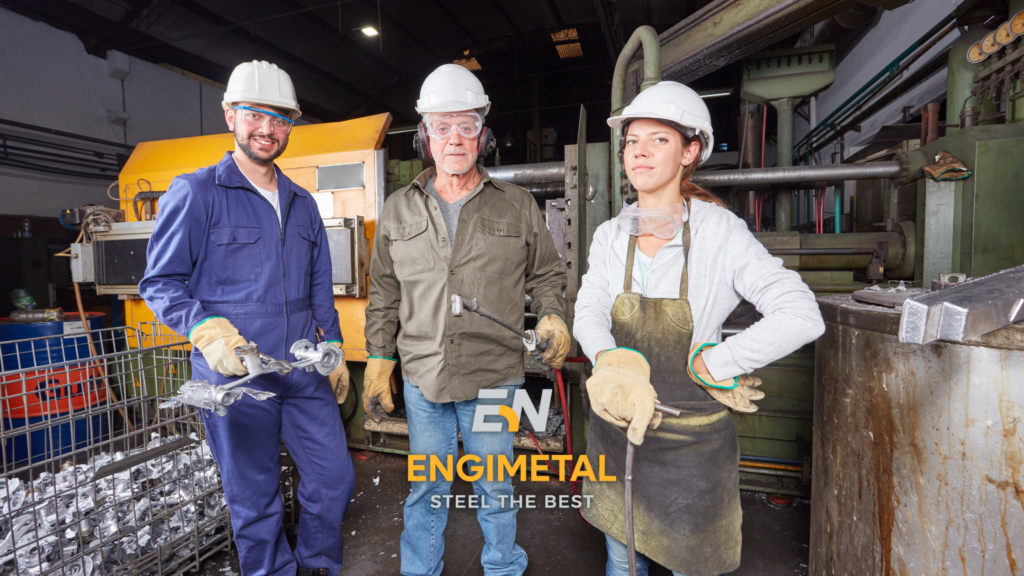
A casting cannot be made without the right mold, and this in turn cannot be created without the use of the appropriate molding sand. Molding sand is a special mixture that, after being placed in a mold and hardened, creates a precisely reproduced casting. There are many types of molding sands, and the choice of the right one depends on many factors, such as the type of alloy, casting technology or the required accuracy of the casting. In this article, we will take a closer look at molding sands in foundry, we will discuss their division and application, and we will find out what factors affect the quality of the casting.
In the past, we wrote for you, among others, about furan and bentonite sands used in foundry.
Molding sands are materials used in the casting process, where they are used to create the mold in which the castings or the casting cores will be made. Their main purpose is to ensure the proper quality and accuracy of the casting, as well as protection against the influence of high temperatures and pressure on the casting. The molding sand can fill the space between the model and the inner surface of the mold, which allows to obtain the desired shape and dimensions of the casting. In the foundry industry, various types of molding sands are used, depending on the material from which the casting is made and the size and complexity of the detail. Depending on the application, molding sands can therefore have a wide range of properties, such as hardness, plasticity, resistance to deformation and many others.
When talking about their features, attention is paid to parameters such as:
In the case of the foundry industry, the molding sand plays a key role in the molding process as it is responsible for creating accurate shapes, surface finish and stability of the mold during casting. Thanks to the use of properly selected molding sands, it is possible to cast elements with complex shapes, as well as obtain precise details with the highest surface quality.
The most commonly used molding sands include synthetic sands, which include:
Another popular type of molding sands are organic sands, which consist of:
As we mentioned above, the materials from which molding sands are made depend on the specific needs resulting from their use. And so, depending on the application and type, we can distinguish between:
How to make a casting mold? Application of molding sands
Please note that the process of making a casting mold may vary depending on the type of mass being cast, the technology used and other factors. However, we can basically describe the process of preparing a mold from molding sands in a few simple steps.
Regeneration of molding sands consists in restoring their functional properties after use. During the casting process, the molding sand is heated and then cooled, which causes its degradation. In addition, impurities such as particles of metals and their castings, fumes and semi-finished products of the casting process remain in the molding sand during casting, which negatively affect its quality. In order to restore the molding sand to its properties, a regeneration process is used. It consists in recovering the proper raw material from the used molding sand, and then processing it and adding it to the newly produced sand. In this way, a new molding sand with similar properties and quality is created from the used molding sand, which allows it to be reused in the foundry process. In the case of some molding sands (e.g. bentonite) it is possible to recycle up to 90% of the molding sand.
In the case of organic molding sands, regeneration consists in adding new binders and hardeners, thanks to which the sand regains its consistency and properties. In the case of inorganic sands, e.g. from clay, regeneration consists in mixing the used sand with a new one, which allows for the recovery of properties.
The regeneration process has a positive impact not only due to the cost of production and reduction of the cost of disposal, but also the reduction of waste, and thus the environment.
Nowadays, due to changing climatic and environmental requirements, more and more emphasis is placed on the search for pro-ecological solutions in various industries, including foundry. Recently, there have been many innovative and sustainable ideas in the field of foundry.
One of such ideas is the use of new materials for the production of molding sands. Molding sands made of natural materials, such as corn starch, clay or rice flour, are already available on the market. They are more environmentally friendly and can be recycled, which reduces the amount of waste generated in the foundry process.
Solutions are also sought to improve the currently used, efficient molding sands, which, after replacing coal dust, turn out to be highly ecological. We wrote about one of such discoveries, developed by a team from the AGH University of Science and Technology in Krakow, in the article on bentonite sands in foundry.
Another interesting solution is the use of 3D printing for the production of casting molds. This technology allows for faster and more precise mold production, which in turn increases the efficiency of the foundry process and reduces the amount of waste. 3D printing also allows the use of renewable raw materials for the production of molds, which contributes to environmental protection.
If you have any questions or want to know our offer, do not hesitate to ask.
